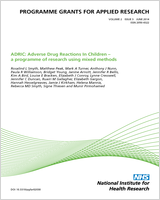From: Chapter 6, OCTET Trial

Coercion in mental health: a trial of the effectiveness of community treatment orders and an investigation of informal coercion in community mental health care.
Programme Grants for Applied Research, No. 4.21.
Burns T, Rugkåsa J, Yeeles K, et al.
Southampton (UK): NIHR Journals Library; 2016 Dec.
Copyright © Queen’s Printer and Controller of HMSO 2016. This work was produced by Burns et al. under the terms of a commissioning contract issued by the Secretary of State for Health. This issue may be freely reproduced for the purposes of private research and study and extracts (or indeed, the full report) may be included in professional journals provided that suitable acknowledgement is made and the reproduction is not associated with any form of advertising. Applications for commercial reproduction should be addressed to: NIHR Journals Library, National Institute for Health Research, Evaluation, Trials and Studies Coordinating Centre, Alpha House, University of Southampton Science Park, Southampton SO16 7NS, UK.
Included under terms of UK Non-commercial Government License.
NCBI Bookshelf. A service of the National Library of Medicine, National Institutes of Health.